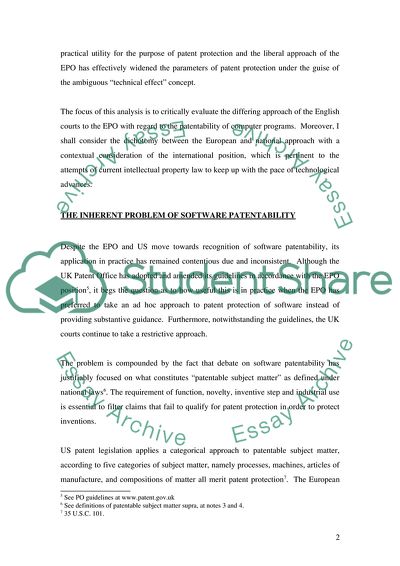Cite this document
(The Inherent Problem of Software Term Paper Example | Topics and Well Written Essays - 3500 words, n.d.)
The Inherent Problem of Software Term Paper Example | Topics and Well Written Essays - 3500 words. Retrieved from https://studentshare.org/law/1719203-in-relation-to-the-patentability-of-an-alleged-invention-which-comprises-or-includes-a-computer-program-explain-how-the-approach-currently-adopted-by-the-english-court-of-appeal-differs-from-the-approach-currently-adopted-by-the-european-patent-office
The Inherent Problem of Software Term Paper Example | Topics and Well Written Essays - 3500 words. Retrieved from https://studentshare.org/law/1719203-in-relation-to-the-patentability-of-an-alleged-invention-which-comprises-or-includes-a-computer-program-explain-how-the-approach-currently-adopted-by-the-english-court-of-appeal-differs-from-the-approach-currently-adopted-by-the-european-patent-office
(The Inherent Problem of Software Term Paper Example | Topics and Well Written Essays - 3500 Words)
The Inherent Problem of Software Term Paper Example | Topics and Well Written Essays - 3500 Words. https://studentshare.org/law/1719203-in-relation-to-the-patentability-of-an-alleged-invention-which-comprises-or-includes-a-computer-program-explain-how-the-approach-currently-adopted-by-the-english-court-of-appeal-differs-from-the-approach-currently-adopted-by-the-european-patent-office.
The Inherent Problem of Software Term Paper Example | Topics and Well Written Essays - 3500 Words. https://studentshare.org/law/1719203-in-relation-to-the-patentability-of-an-alleged-invention-which-comprises-or-includes-a-computer-program-explain-how-the-approach-currently-adopted-by-the-english-court-of-appeal-differs-from-the-approach-currently-adopted-by-the-european-patent-office.
“The Inherent Problem of Software Term Paper Example | Topics and Well Written Essays - 3500 Words”, n.d. https://studentshare.org/law/1719203-in-relation-to-the-patentability-of-an-alleged-invention-which-comprises-or-includes-a-computer-program-explain-how-the-approach-currently-adopted-by-the-english-court-of-appeal-differs-from-the-approach-currently-adopted-by-the-european-patent-office.


